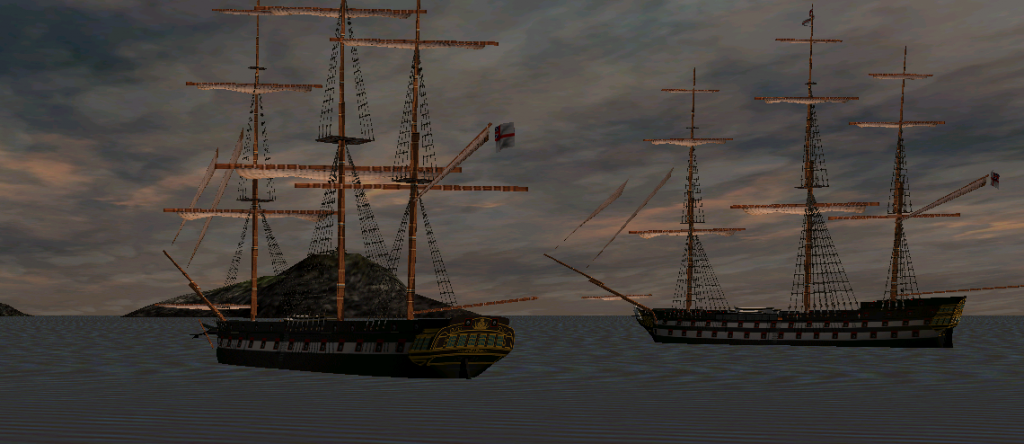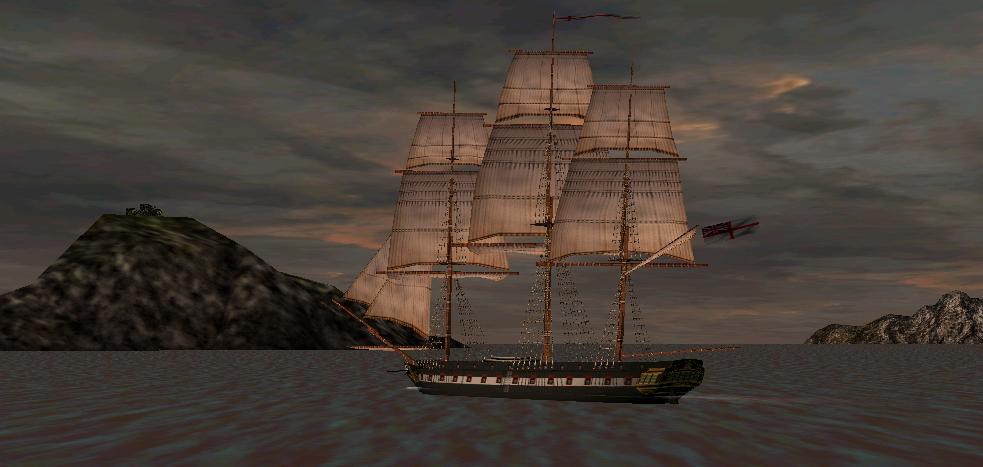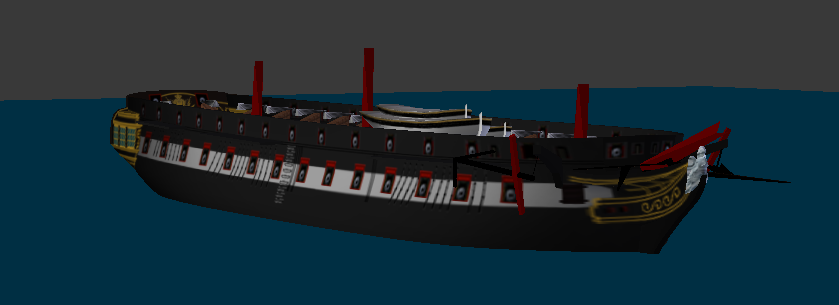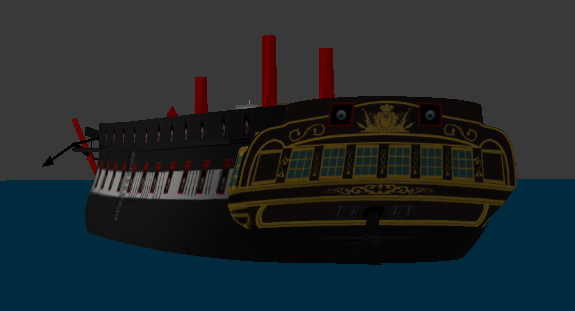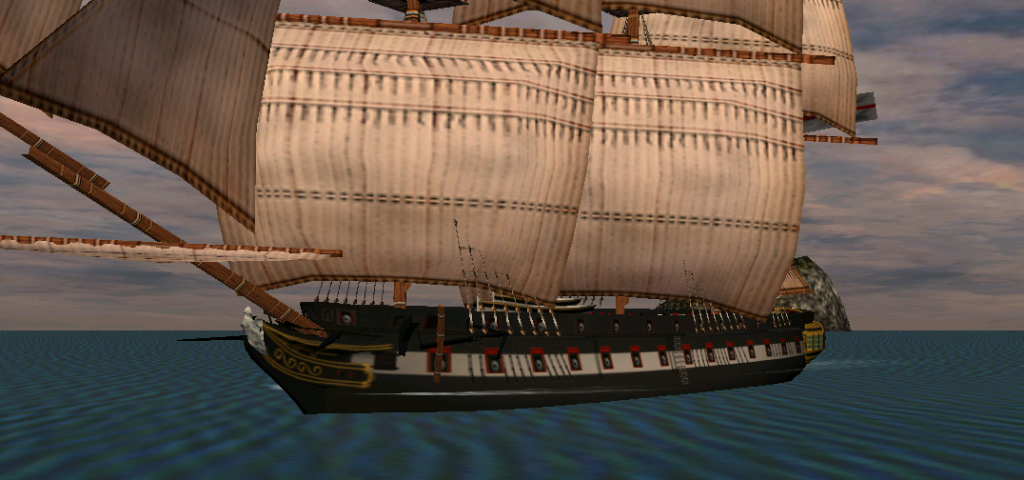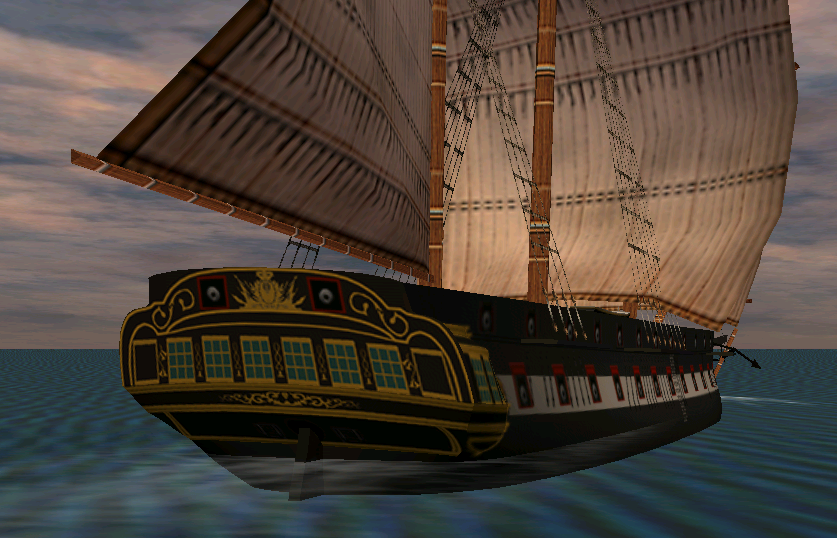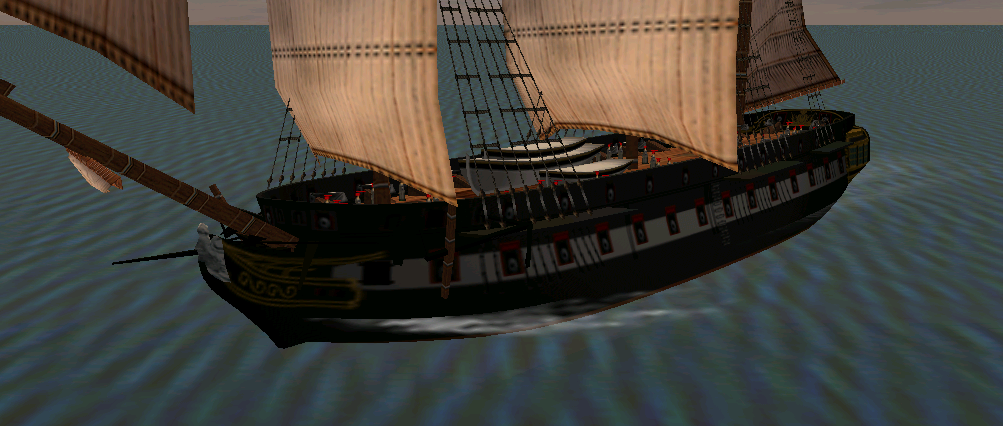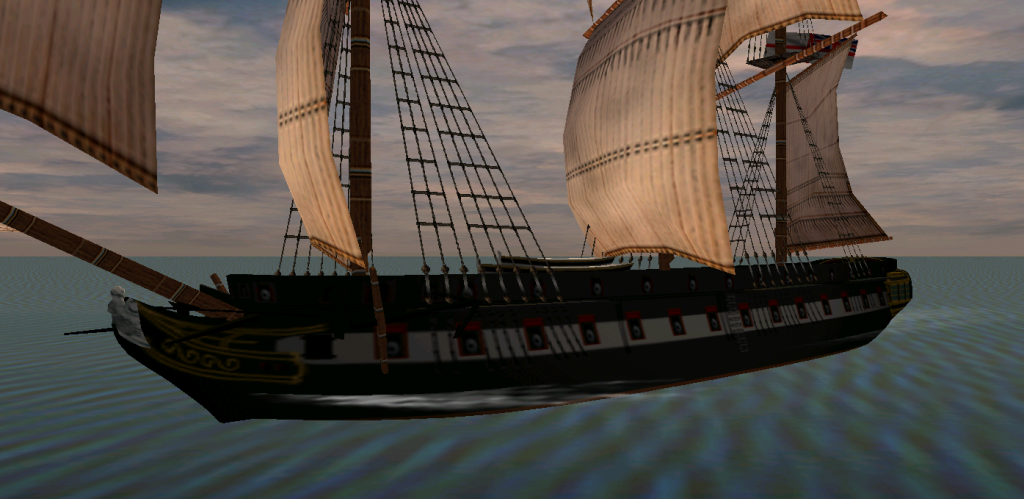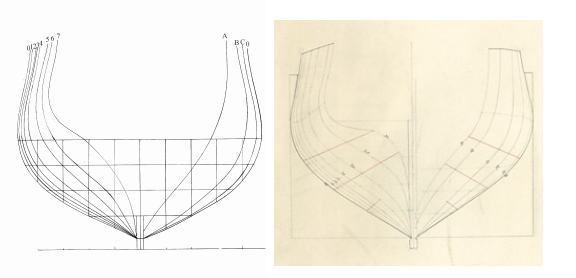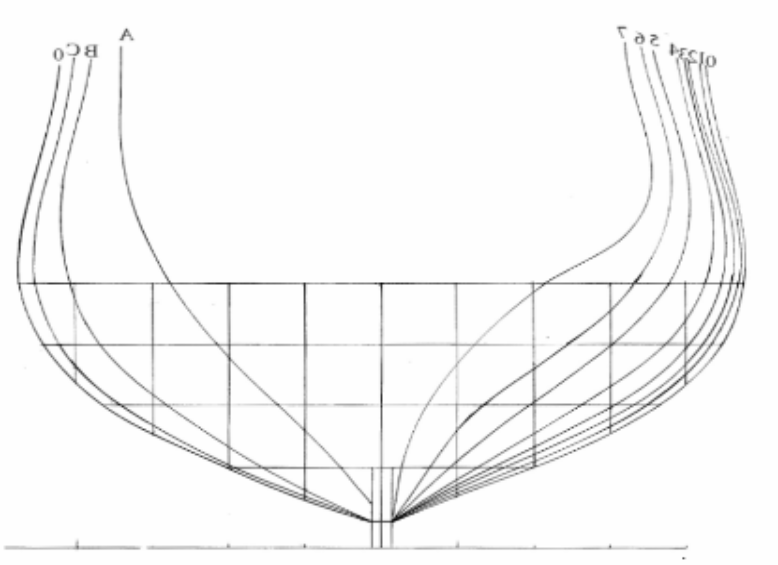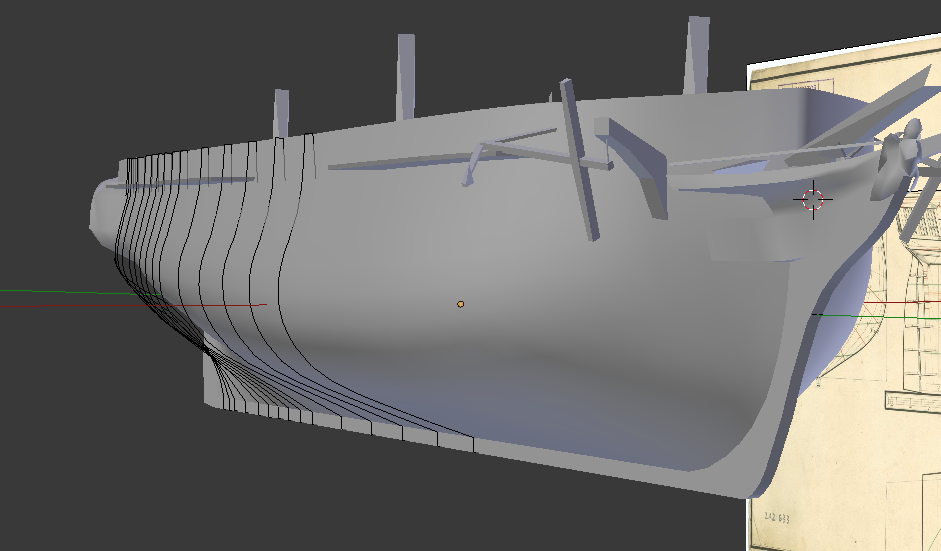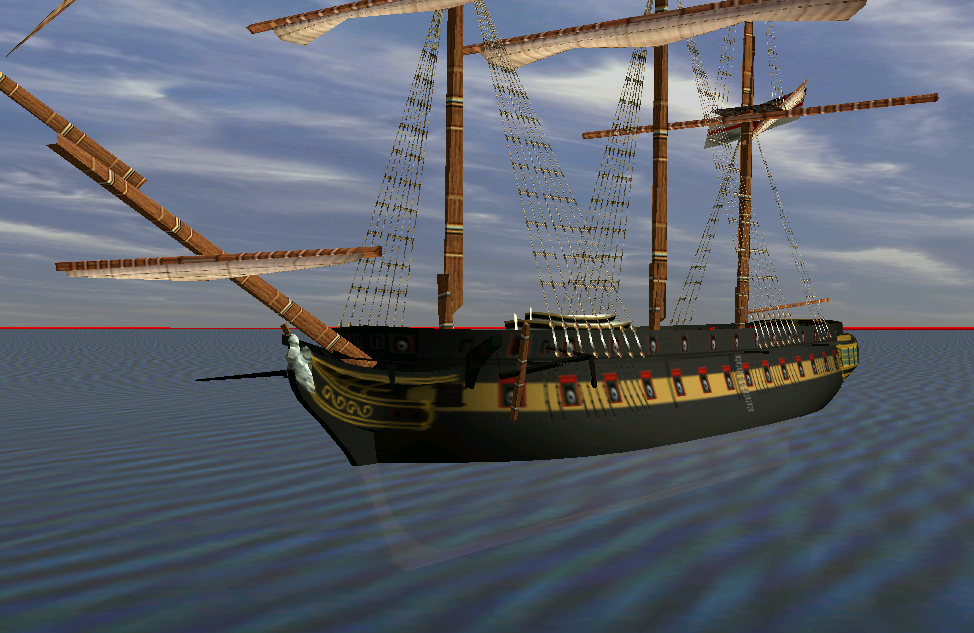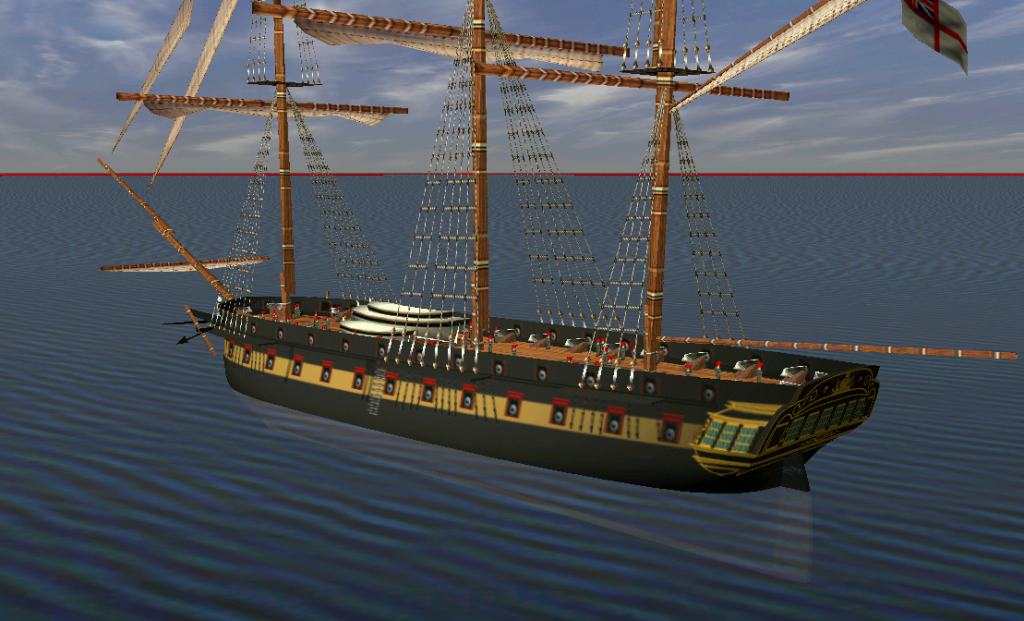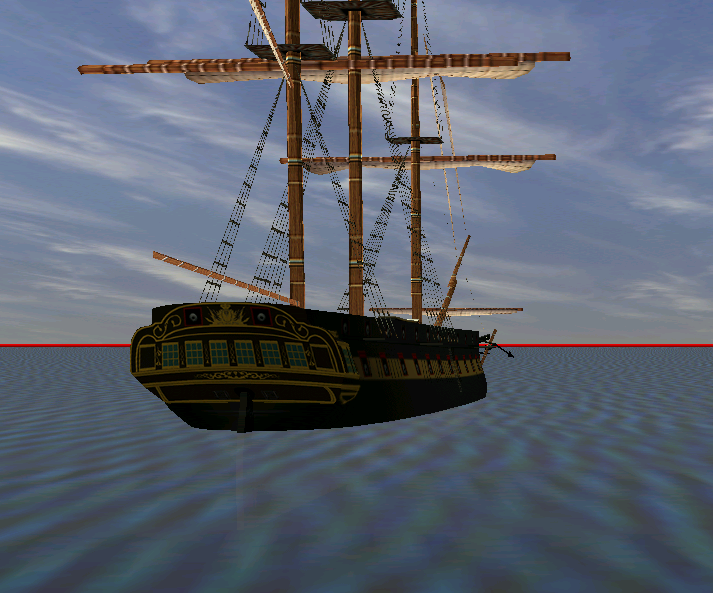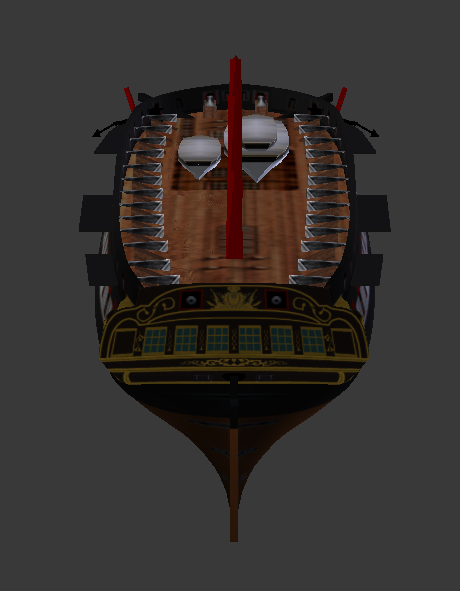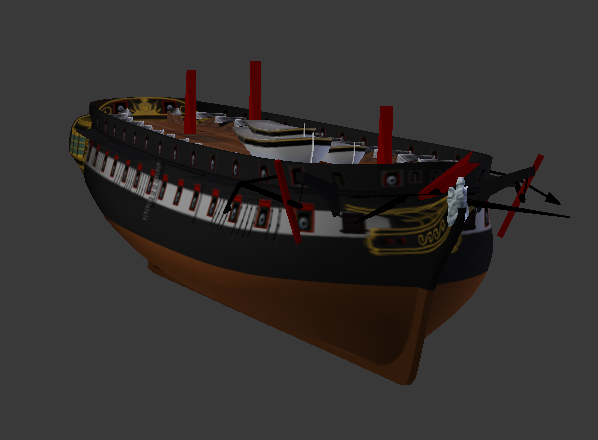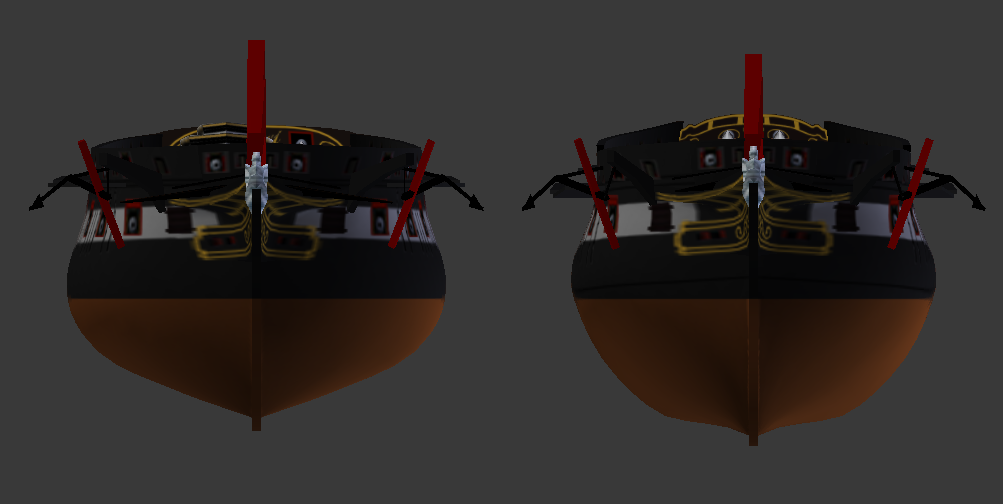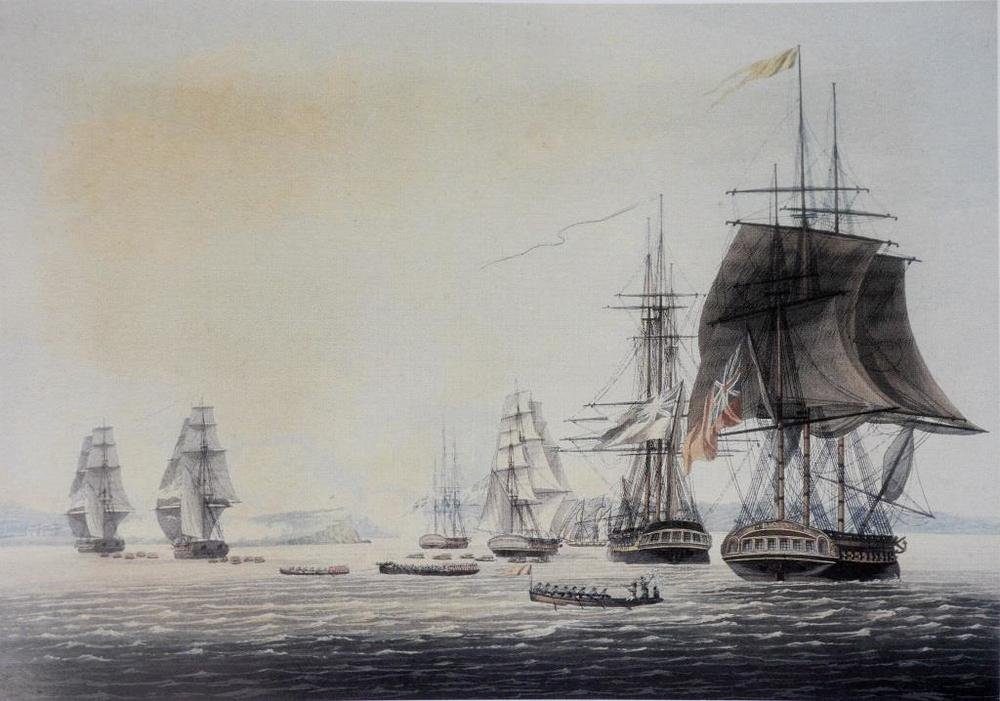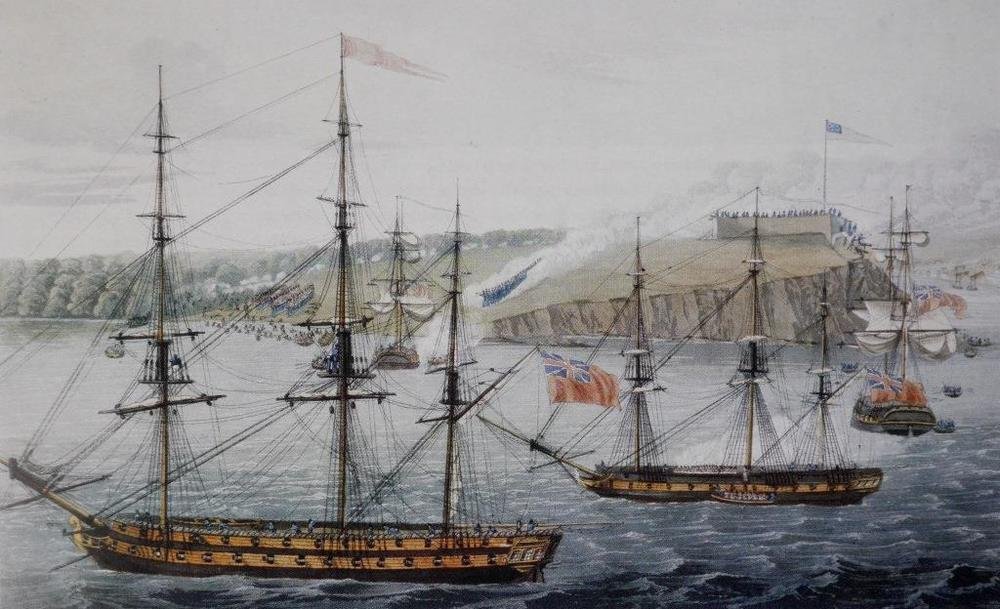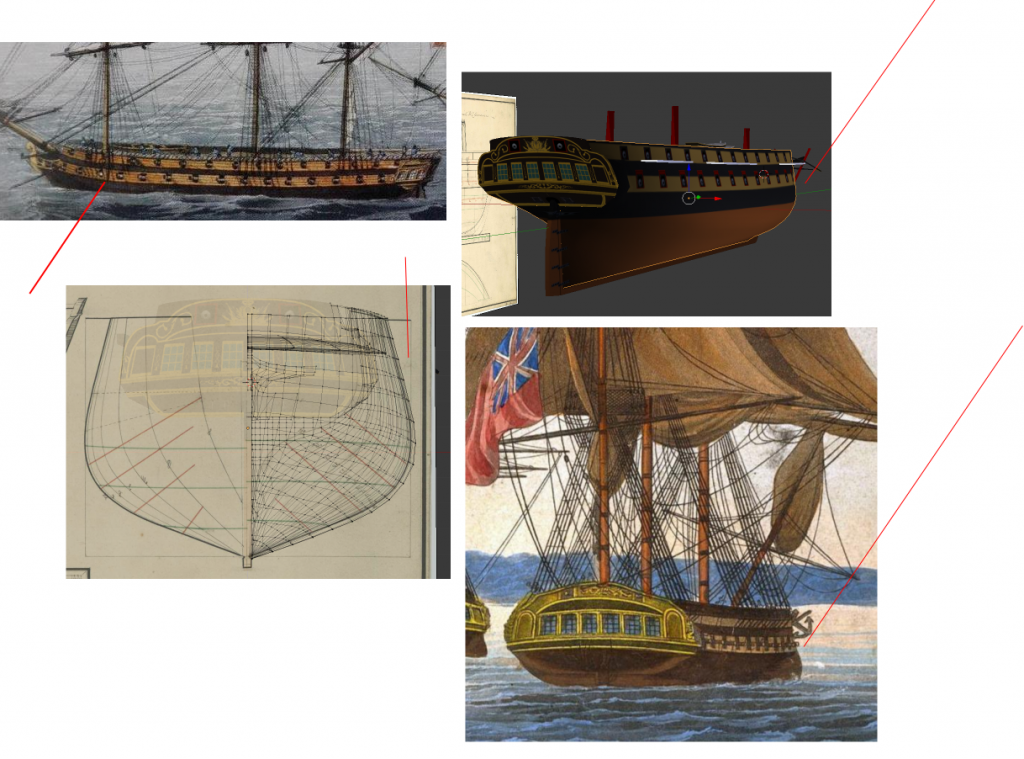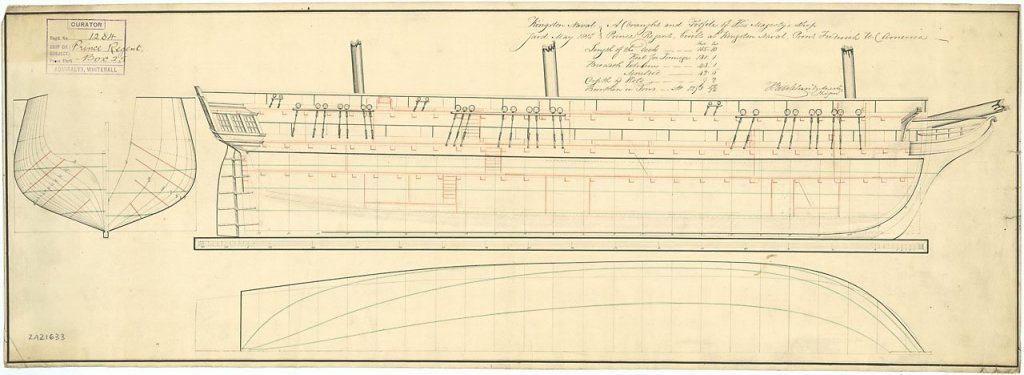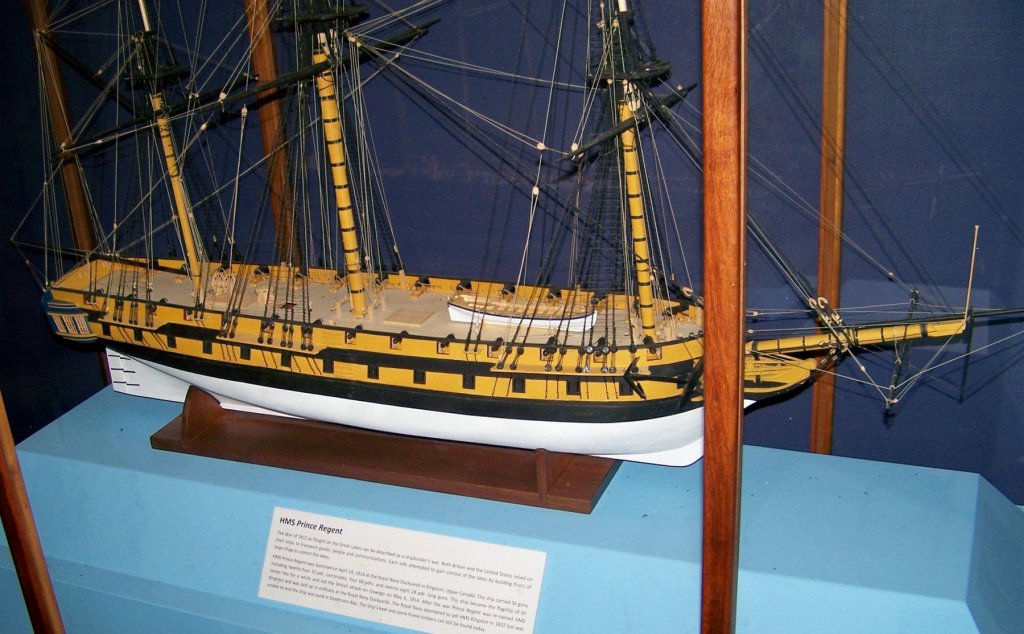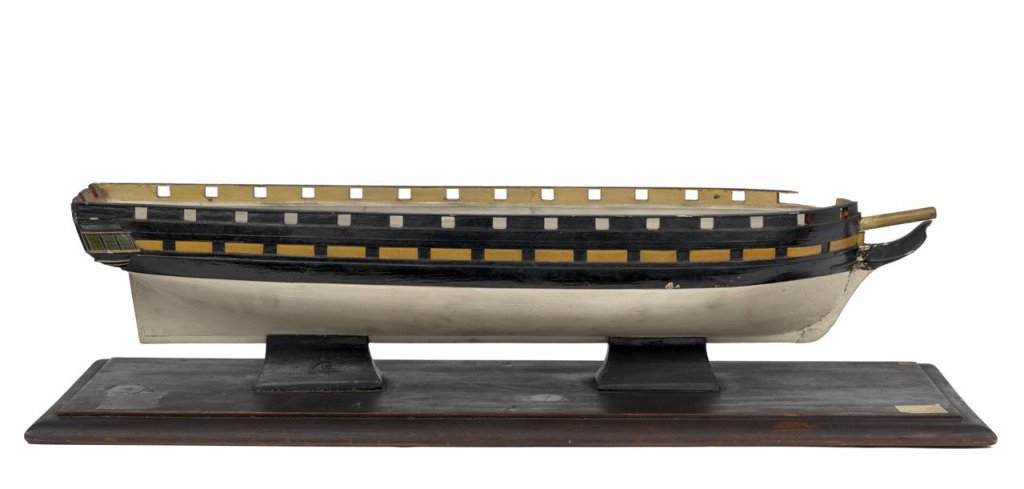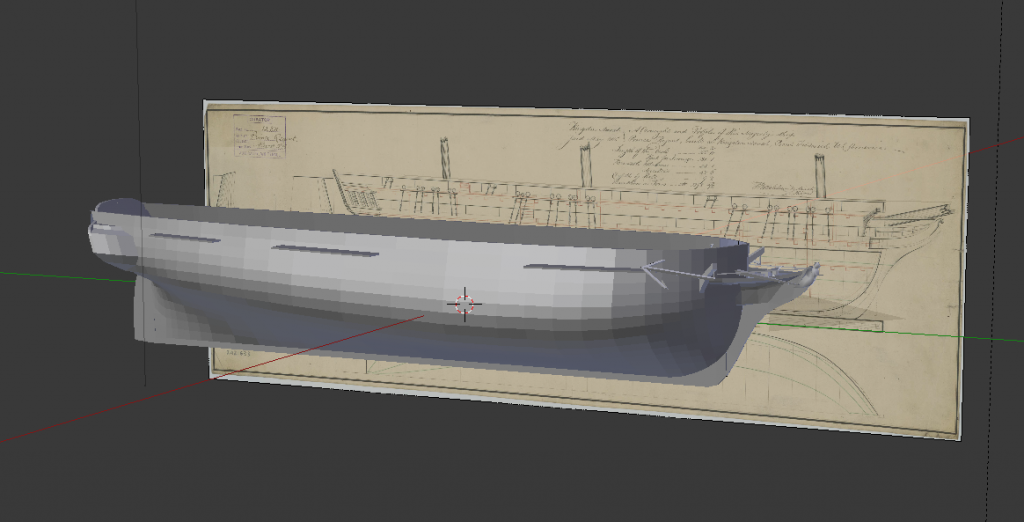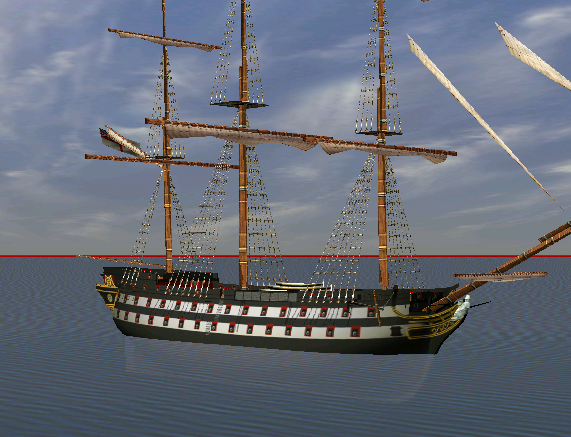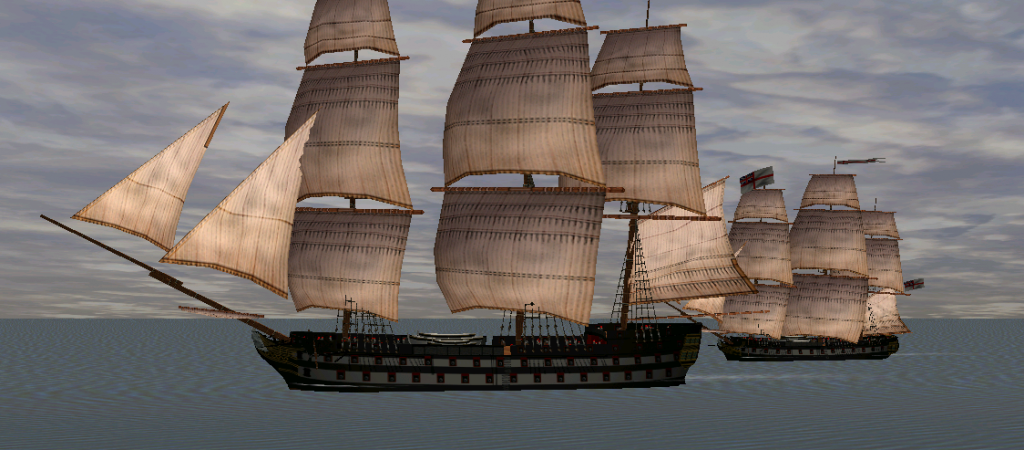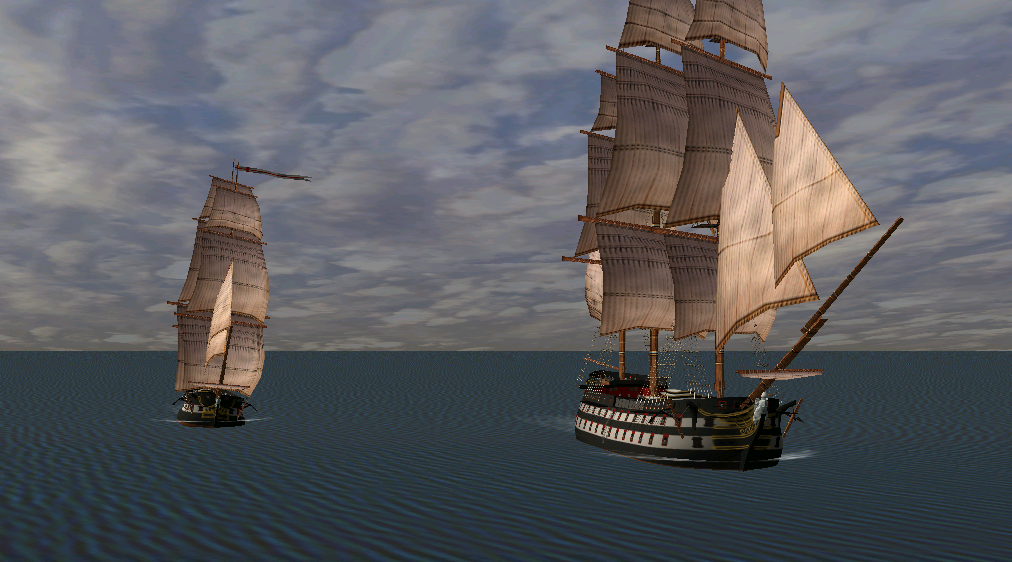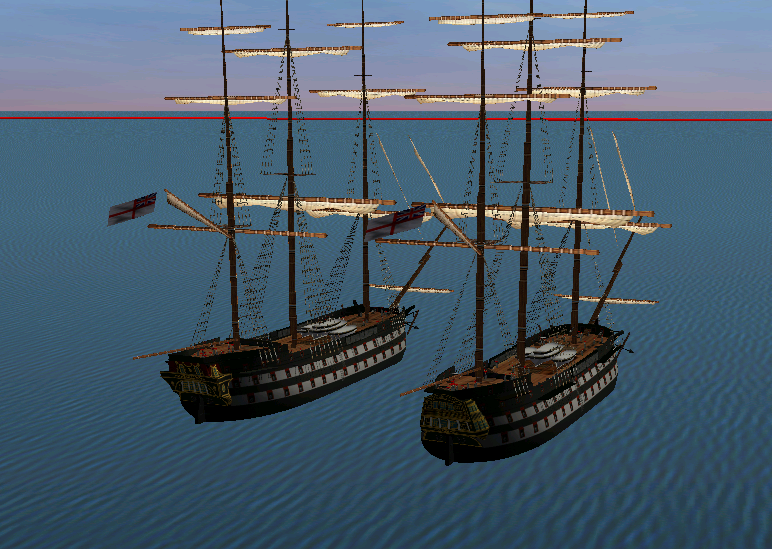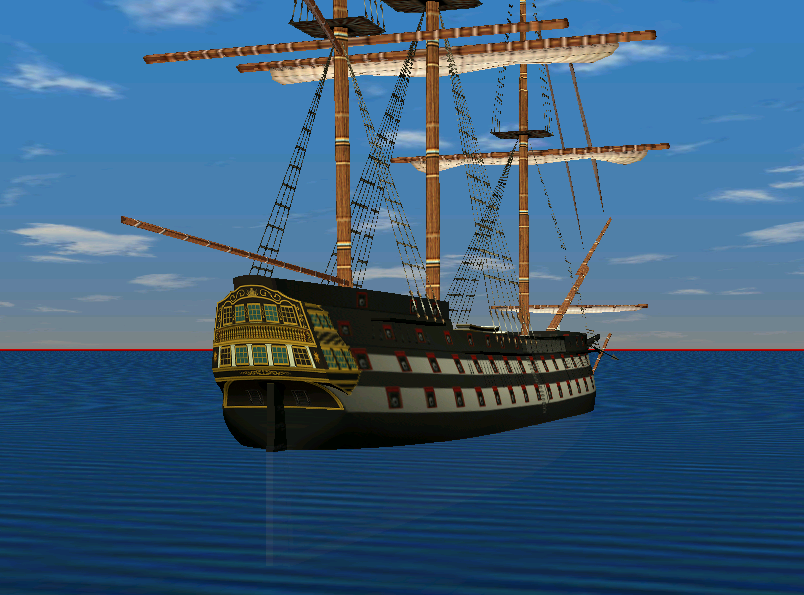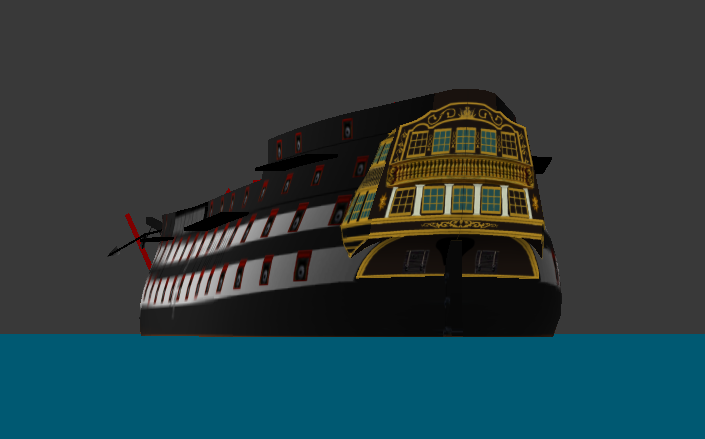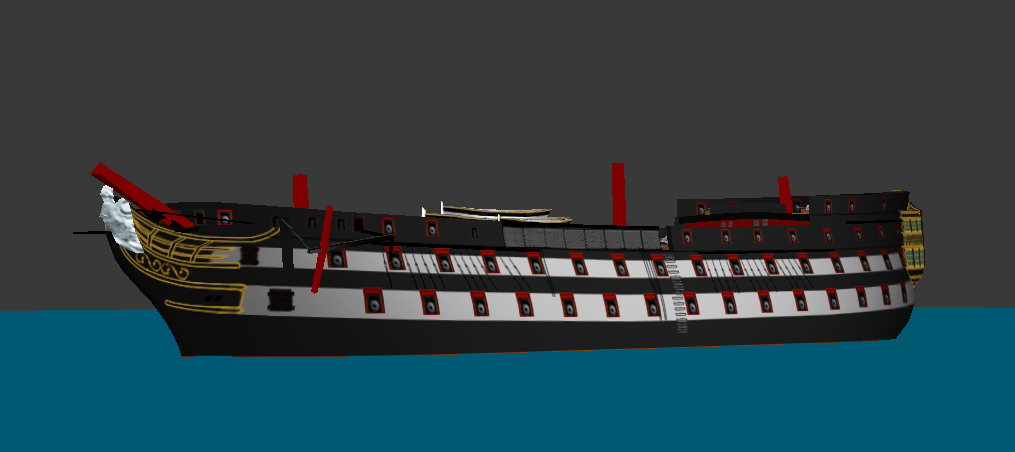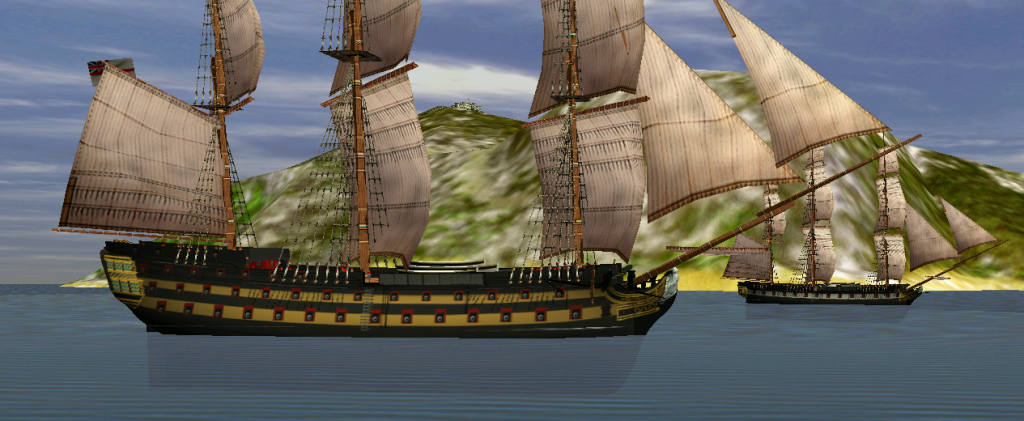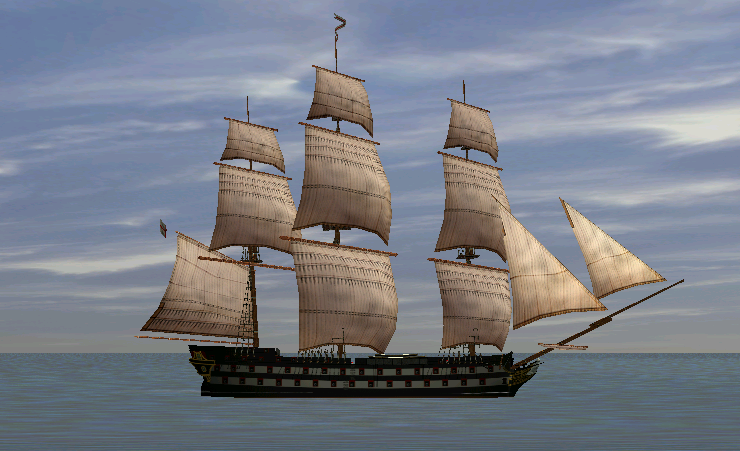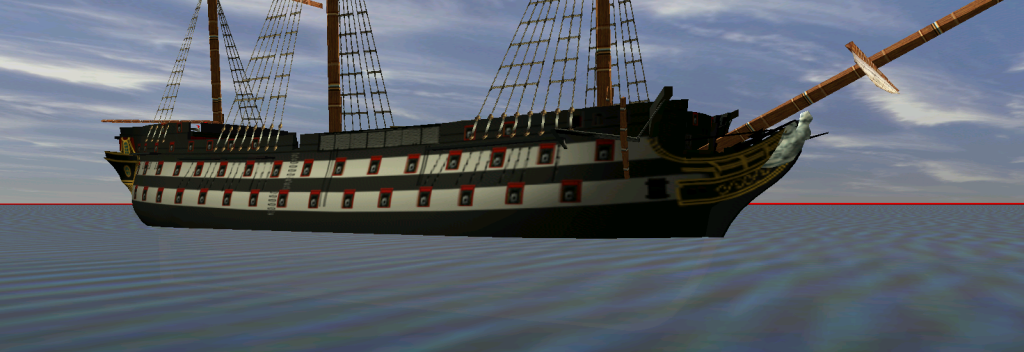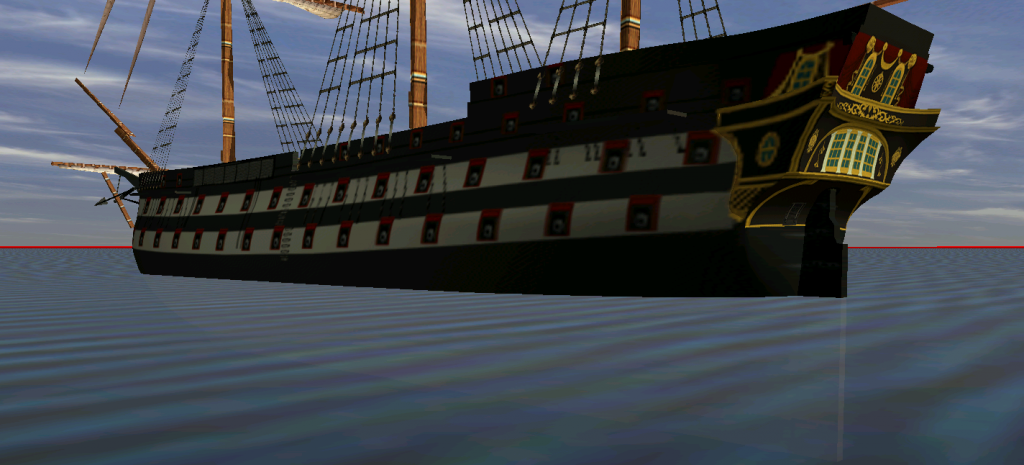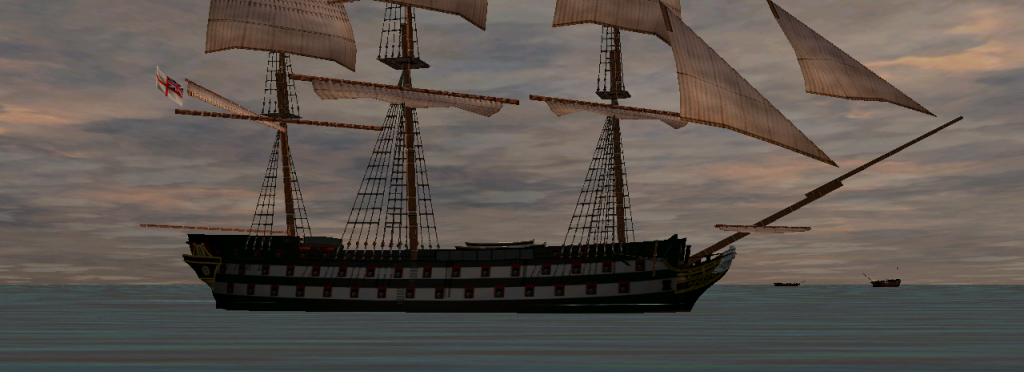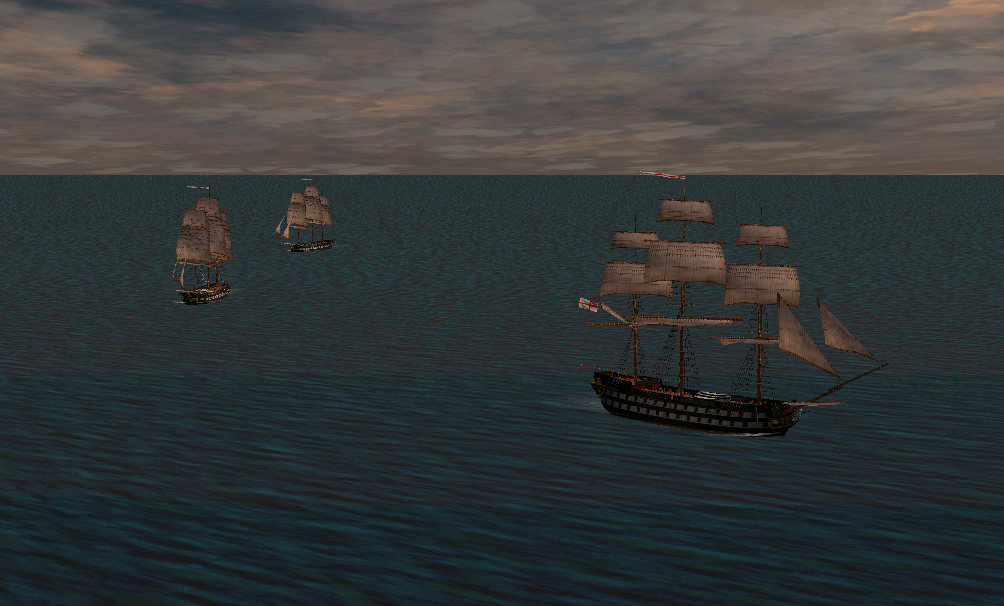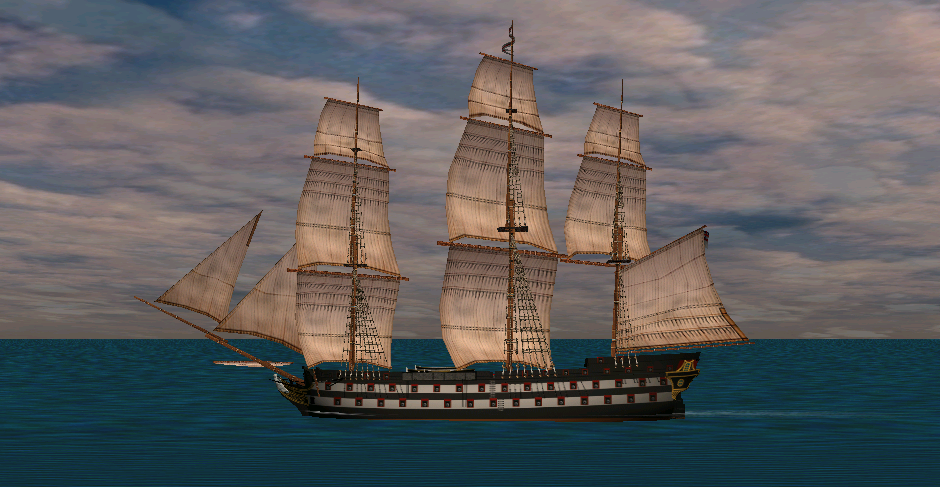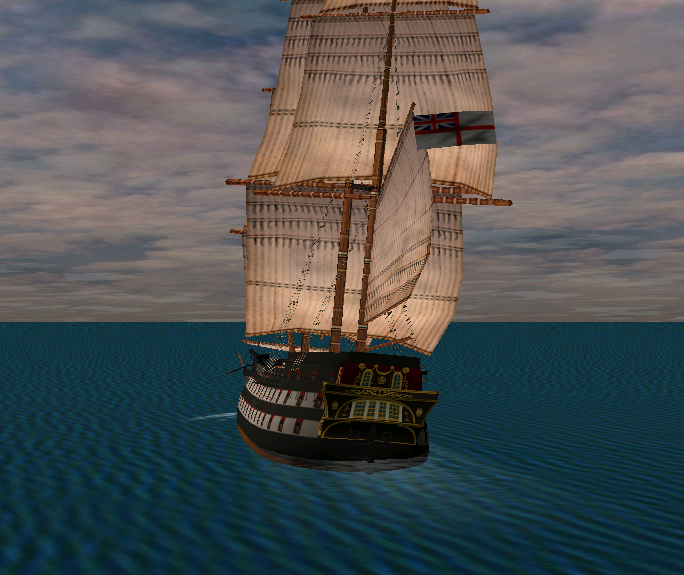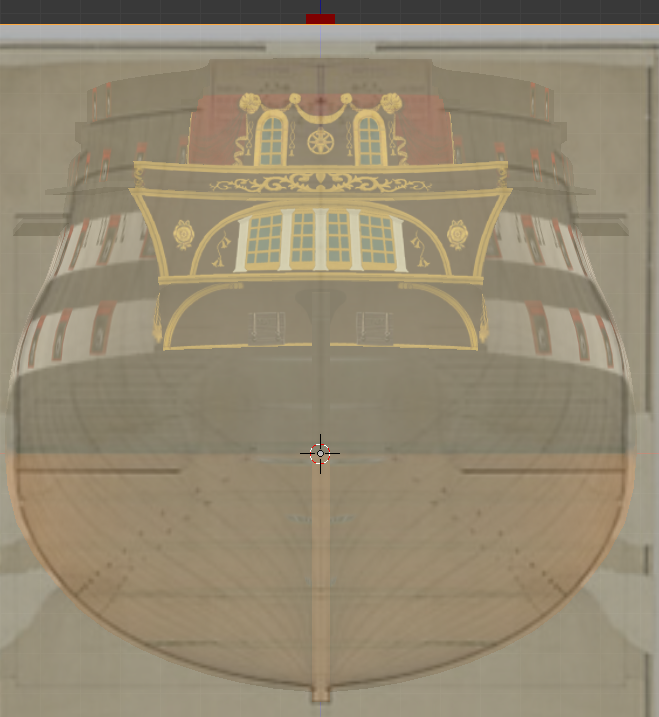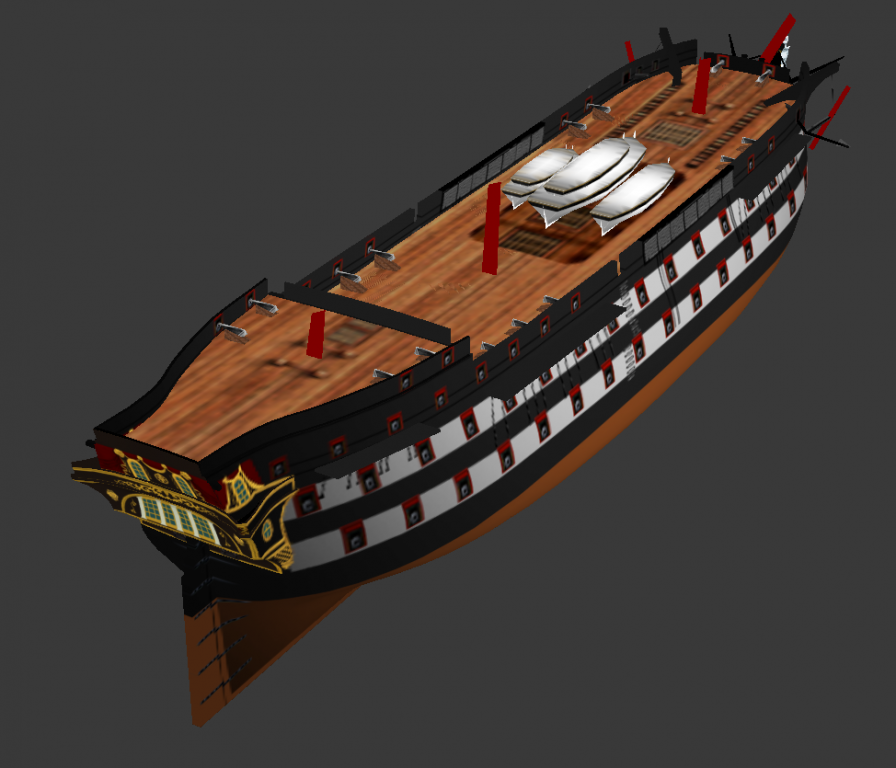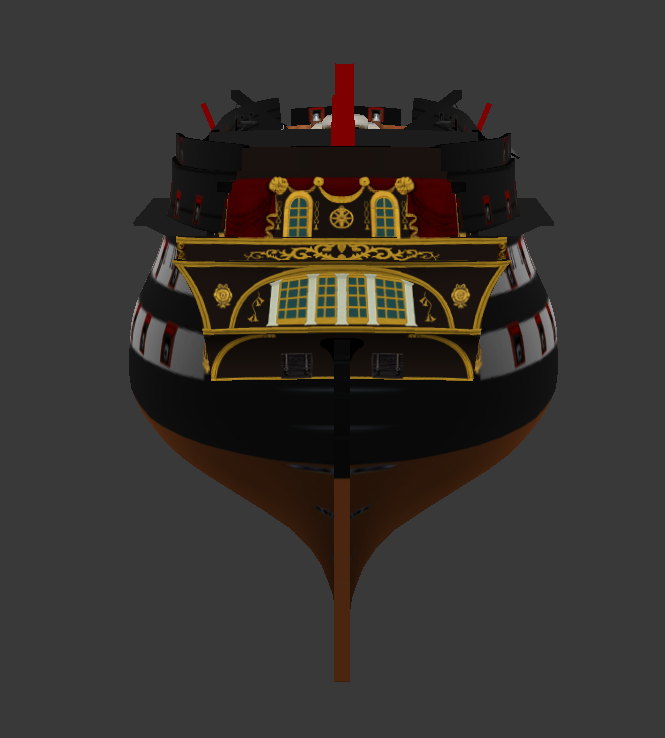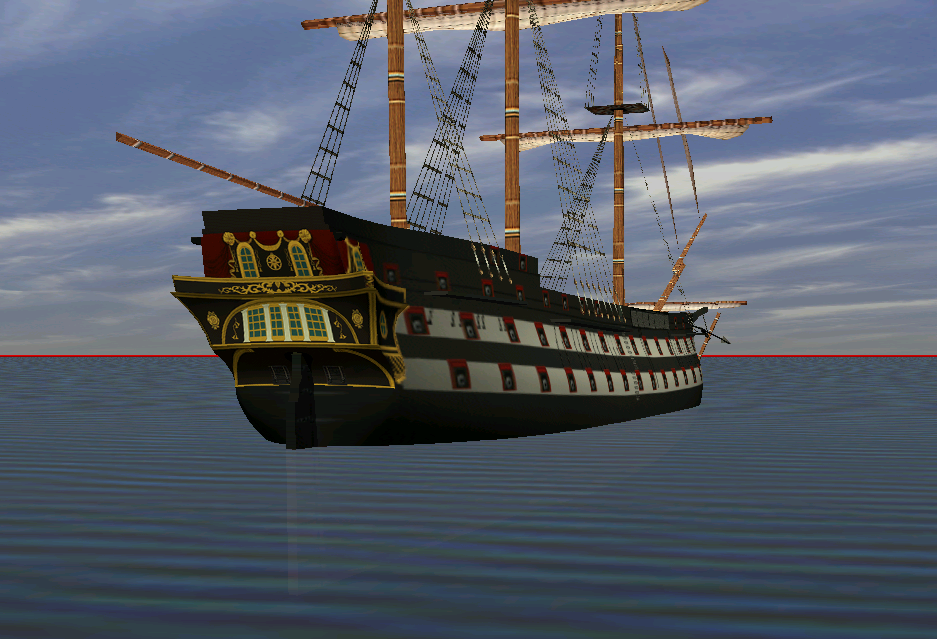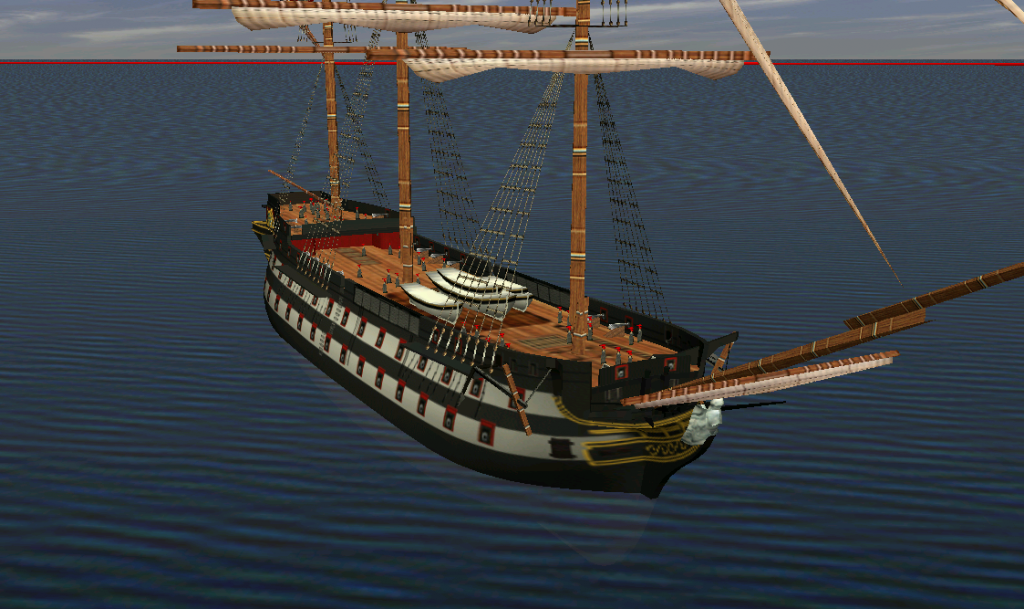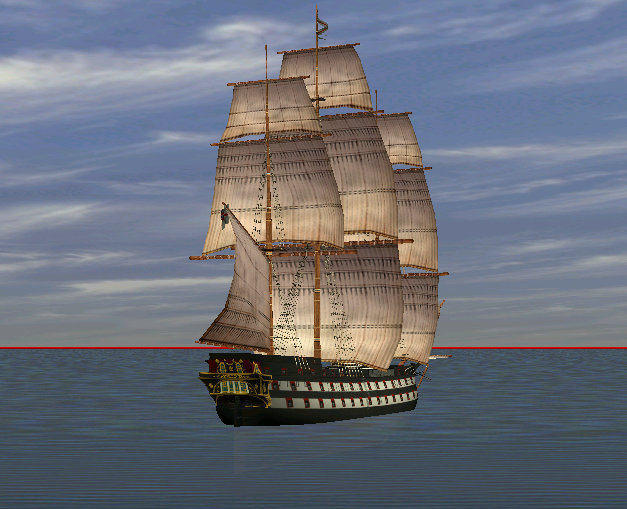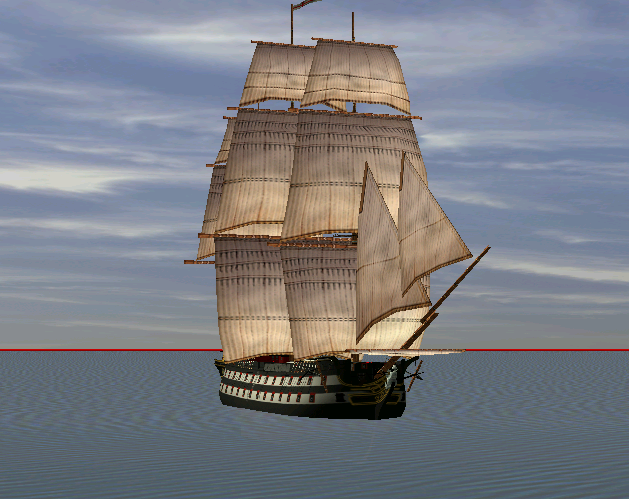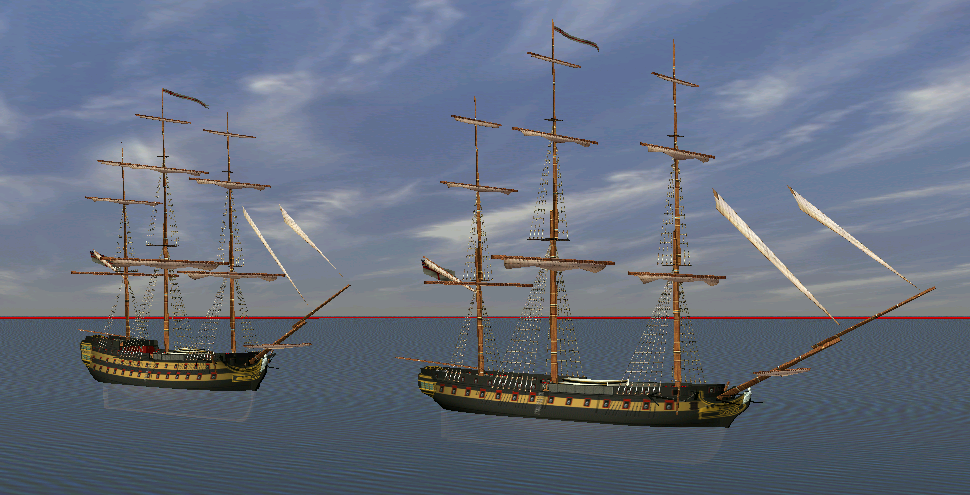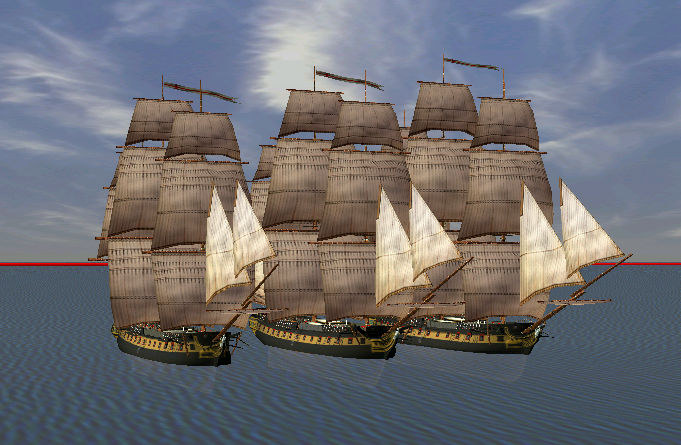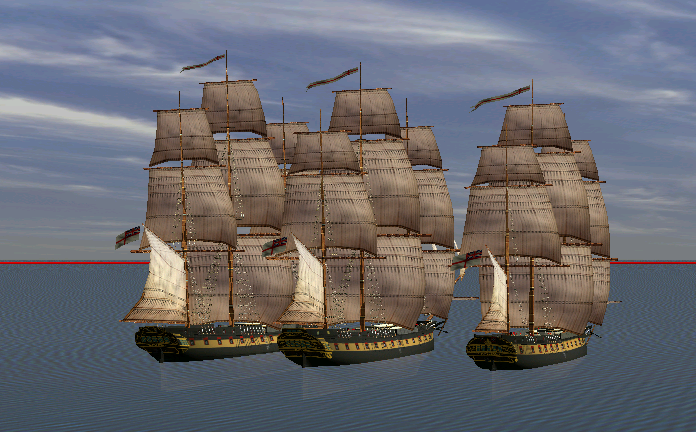-
Posts
964 -
Joined
Content Type
Profiles
Forums
Gallery
Events
Everything posted by Martes
-
Adjusted the stripe and made some other little corrections to the texture - and here she is under sail: The ship may still appear a little peculiar, since it's widest point is still well forward of the midships, although it's not as noticeable as before. It seems to be Goudie's trademark form, featuring in all the three designs (Pr. Charlotte, Prince Regent and St. Lawrence) - was he influenced by Stalkartt, I wonder?
-
Haven't thought about it, but yes, it also must have influenced the design. Although the hull from the Strickland plan (post 1) has, I am afraid, problems with buoyancy in any kind of water. It is also interesting, how this design is mostly free of the French influence, something rather unusual for the British at that time.
-
To be entirely correct, I started by experimenting with adding a tumblehome and then my concern turned over to the terrible lack of buoyancy of the stern, especially considering the weight of armament - and that's when the Princess Charlotte plans came in. I supposed that they would be close to each other being built by the same Mr. Goudie, and thus they have to share at least some design principles. Left - Princess Charlotte as reconstructed by Mr. Walker, right - Strickland's lines Longitudinal positions of the frames are more or less the same. Here we do see a tumblehome and a substantial stern, and the midship section looks very much like the Prince Regent. It has to be noted (again, quoting Mr. Walker): This maybe explained by the fact that when the Strickland plan was produced, the ship was in the water and the view of the stern post was obscured. So much for accuracy, as no one bothered even to get the ship out of the water to measure the hull. But then it was 1817 and the lake was demilitarized so nobody, I guess, saw any importance in these ships. This led me to try and superimpose the Princess' lines over the Prince Regent, which required stretching them a bit: but I was astonished how well they coincided with the general shape and my experimental tumblehome. Then it was only a question of reconstructing the frames between and shaping the sternpost. And the final shape turned to look so well balanced I thought I got it more or less right. Of course, the real wreck can prove it was different, but until then...
-
First I overlayed the reconstructed Princess Charlotte on the drought of Prince Regent, and widened it to fit the dimensions. It is possible to see, there are definite similarities, but the lines are much fuller at ends and the curvature of the upper works is different. Then I made the new frames and positioned them roughly according to their position on the Princess Charlotte and referencing so that the deck line will be more or less even and added a slight tumblehome: It turned out even the positions of the gunports had to be altered relatively to the plan, and the final result looks like this: And especially for comparison with the engravings: I can't say I am totally sure this is how the Prince Regent looked like, but it certaily looks like a heavy frigate, capable of carrying her battery of 28 24-pounders. Slightly shallow, but it would look well enough on the Baltic, Mediterranean, or the French Coast blockade. Compare with an ocean-going frigate (Liffey, roughly the same armament, on the right on both images): Some techincal remarks. 1. The plan does not show a figurehead at all (a scroll), and the engraving shows something like a swan figurehead, so I retained the standard model I use for all other ships to keep it uniformed. 2. The stern decoration is, in fact, taken from the plans of Imperieuse as refitted, it was the closest to the one depicted on the engraving. Curiously, the Prince Regent looks rather futuristic for her times - in my reconstruction, at least, I got certain similarity to the Inconstant and the Pique built in the 1830s, without the elliptic stern, of course.
-
Apart from the plans, there are two images of the Prince Regent known - both illustrations of the attack on Oswego. And the more the model was taking shape, the less it looked like the ship portrayed on both of the images. The absence of tumblehome, for one, the and avery, very sharply narrowing stern. And overall sense of too light a structure for that number of heavy guns. So I went to investigate and found a thesis by a Mr. Daniel Walker concerning the wreck of the Princess Charlotte, the smaller lake frigate. It makes a fascinating reading itself, but it gave me a crude revelation: Strickland's plans are endeed completely inaccurate comparing to the surviving frames of the ships. They seem to get the profile right and the main dimensions, but everything else is doubtful. Unfortunately, I wasn't able to contact Mr. Walker himself, perhaps due to an outdated email address, so I do not have any information if he attempted to make a frame reconstruction of the Prince Regent, but I did notice that the reconstructed lines of the Princess Charlotte, given in the above thesis do look rather close to the form of the Prince Regent as it is depicted on the engravings. Thus I set to the wild speculation I am about to present. Of course, I am aware my reconstruction attempt may be erroneous, but the resulting frigate looks feasible enough for it's size, it's battery and the contemporary images by somebody who, apparently, saw her in action.
-
While it is still an addition to my warship collection, the process behind this model turned out so complicated I thought it deserves a separate post. The Prince Regent was built in Kingston, Canada, on the Lake Ontario during the War of 1812 and even saw some action then. At some point after the war the ships on the lake were surveyed by Thomas Strickland, who made the plans later conveyed to London and they ended up in the NMM collection: The plan shows a very straightforward ship, literally - flat sheer, and the widest point well forward of the midship, features, apparently, characteristic to the builder. Unsuspecting and relying on the fact somebody definitely built a model to those plans, and even one relatively contemporary: I set off with my own build. And then the problems began.
-
Outfitting the HMS Cambridge (1815): An 80-gun ship that was very closely based on the Christian VII it's usually considered a copy, but there was a substantial number of changes that required to remake the model almost from scratch - circular bow, raised head, an attempt to make more traditional, but narrowed stern (which ended up probably even more awkward than the original ), and straightened sheer of the decks. In addition to false keel, the ship was designed for slightly deeper drought, and that required corrections to entry fore and aft, and a little raised tumblehome curve. The result is characteristic Victorian ship, representative of the Royal Navy up to the age of ironclads.
-
Made a small adjustment to the roundhouse of Christian VII to denote the border between the poop deck and upper quarter galleries that actually form a single structure and covered with bulwarks from outside. It's not really final form, but seems closer to original than simple deck covering from board to board. Blows my mind each time I look at it. And two shots under sail:
-
I am absolutely exhausted - this ship ate my mind for almost half a year - to present the completed Christian VII: It wouldn't even be possible without the fortunate high-resolution drawings being available at the Danish archive and a photo of a contemporary model provided by @malachy (and tons, literally tons of other reference materials I scavenged everywhere I could, really), since the stern is hellishly unusually built, but... here she is. It's the most complex model I did for now, and I am very delighted that at around 8k triangles the game can still handle her.
-
Coppering color
Martes replied to Martes's topic in Painting, finishing and weathering products and techniques
Huh, it is a little simpler than that. Since I am making 3d models that I want to look relatively natural within a computer game, it's all more or less about a color of a texture, and seeing the photos of Trincomalee in dock I began to doubt what actually it should be. -
Coppering color
Martes replied to Martes's topic in Painting, finishing and weathering products and techniques
Thank you very much for the reply So, if I understand correctly, the bottom of a coppered ship that is (relatively) constantly moving in water would appear brown-red, not green-blue? -
Something that puzzles me with the coppering of ship's bottoms - what actual color would it be and after how much time in water could it acquire this green hue?
About us
Modelshipworld - Advancing Ship Modeling through Research
SSL Secured
Your security is important for us so this Website is SSL-Secured
NRG Mailing Address
Nautical Research Guild
237 South Lincoln Street
Westmont IL, 60559-1917
Model Ship World ® and the MSW logo are Registered Trademarks, and belong to the Nautical Research Guild (United States Patent and Trademark Office: No. 6,929,264 & No. 6,929,274, registered Dec. 20, 2022)
Helpful Links
About the NRG
If you enjoy building ship models that are historically accurate as well as beautiful, then The Nautical Research Guild (NRG) is just right for you.
The Guild is a non-profit educational organization whose mission is to “Advance Ship Modeling Through Research”. We provide support to our members in their efforts to raise the quality of their model ships.
The Nautical Research Guild has published our world-renowned quarterly magazine, The Nautical Research Journal, since 1955. The pages of the Journal are full of articles by accomplished ship modelers who show you how they create those exquisite details on their models, and by maritime historians who show you the correct details to build. The Journal is available in both print and digital editions. Go to the NRG web site (www.thenrg.org) to download a complimentary digital copy of the Journal. The NRG also publishes plan sets, books and compilations of back issues of the Journal and the former Ships in Scale and Model Ship Builder magazines.




